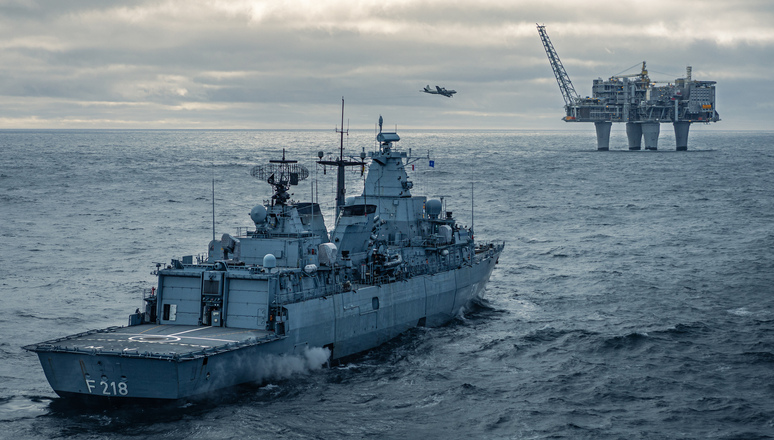As part of attempts to increase the security of underwater infrastructure, Germany and Norway proposed on the margins of the NATO defence ministers’ meeting in Brussels on 17 October 2024 that NATO territory should be divided into five maritime regions, each of which would be managed by a member of the alliance.
Germany assumes responsibility in the Baltic Sea
Norway and Germany are thus proposing the establishment of regional centres for different sea areas, which could be managed by one or more allies who would monitor the underwater infrastructure in the areas. These critical underwater infrastructure (CUI) hubs would cover the Baltic Sea, North Sea, Atlantic Ocean, Mediterranean Sea and Black Sea.
Norway, which alone has over 9,000 km of gas pipelines plus cables for power supply and connecting lines for communication, according to Norwegian Defence Minister Bjørn Arild Gram, wants to take responsibility for the High North.
Meanwhile, according to a press statement released by the German Federal Ministry of Defence (BMVg) on 17 October, Germany is “determined and ready to assume responsibility in the Baltic Sea”.
The German-Nordic initiative is open to all Alliance members, with the defence ministers of the two countries extending an invitation for them to participate.
Norway and Germany have a current bilateral agreement that dates back to an announcement in November 2022, when their heads of government, Jonas Gahr Store and Olaf Scholz respectively, agreed on a proposal for an informal initiative to improve the security of undersea infrastructure.

Nord Stream shock
The four explosions on the bottom of the Baltic Sea near the Danish island of Bornholm on 26 September 2022, along with methane gas leaks from Nord Stream Pipelines 1 and 2, brought critical maritime infrastructure, which had previously been neglected in Germany, to the fore. Disruptions to the Baltic Connector, a 77 km gas pipeline between Estonia and Finland, in the autumn of 2023 only re-emphasised the need to take action.
Since then there have been a number of initiatives in Europe to strengthen the protection of CUI. At the North Sea Summit in April 2023 national security advisors from nine countries met to discuss better co-operation on the security of energy and telecommunications infrastructure. On 9 April 2024 Belgium, Denmark, Germany, the Netherlands, Norway and the United Kingdom agreed on better co-operation and information sharing to protect underwater infrastructure.
NATO, meanwhile, established a Maritime Centre for Critical Underwater Infrastructure Security within NATO Maritime Command (MARCOM) in Northwood, in the United Kingdom, in 2023. Its purpose is to prepare decision making, co-ordinate member states’ actions and support the eventual deployment of maritime capabilities.
In February 2024, the alliance’s defence ministers agreed to set up a Critical Undersea Infrastructure Network. Leading experts from the alliance met at NATO headquarters on 23 May 2024 for the first meeting of the network.
Realities: lack of prioritisation, lack of co-ordination, fragmentation of responsibilities
According to experts, protecting critical infrastructure on the seabed is not only difficult because of the effort involved in monitoring it. Göran Swistek, a naval officer and guest researcher at the German Institute for International and Security Affairs (SWP), has stated, “The Baltic Sea, for example, where the Nord Stream 2 attack occurred, is a relatively small inland sea – but still too large for constant monitoring.
“We have more and more wind farms being built in Danish and German waters. It’s not even possible for a government to monitor them all,’ said Swistek, noting that, although the operators of critical infrastructure have a certain responsibility to protect, they are largely helpless against targeted sabotage.
“All in all, this means that no, we will probably never be able to achieve a situation in which we can protect all existing infrastructure,” Swistek concluded.
There is also the usual question of jurisdiction in Germany. In territorial waters up to the Exclusive Economic Zone, which extends from the coast up to 200 nautical miles into the high seas, the police are responsible. “The navy doesn’t actually have a mandate to protect critical infrastructure,” confirmed Swistek in the ‘Nachgefragt’ series on bundeswehr.org in June 2023.
The status of the current discussion reflects the need to focus and prioritise, as not all maritime infrastructure can be protected from targeted attacks. Taking up the assessment of the situation, the German Institute for International and Security Affairs (SWP) has launched a study to help clarify the current debates at national level, within the EU and among NATO partners. The fundamental questions are: ‘How can the strategic importance of maritime critical infrastructures be summarised? And what is an appropriate understanding of their security?’
Internationally, too, it is becoming apparent that such protective measures have consequences for the institutional and political framework. This includes a review of legal instruments, doctrines and the deployment of personnel and resources. At a seminar on maritime security organised by the Belgian EU Council Presidency on 16 April 2024 with a focus on the North Sea, the Mediterranean Sea, the Black Sea and the Gulf of Guinea, there was unanimous agreement on the indispensability of a regional approach to the protection of critical infrastructure, as the existing institutional fragmentation is detrimental to ensuring maritime security. In the North Sea, for example, there is overlap between the Convention for the Protection of the Marine Environment of the North-East Atlantic (OSPAR Convention), International Council for the Exploration of the Sea (ICES), North-East Atlantic Fisheries Commission (NEAFC), North Atlantic Coast Guard Forum (NACGF), NATO Allied Maritime Command (MARCOM) and the European Union Maritime Security Strategy (EUMSS).

